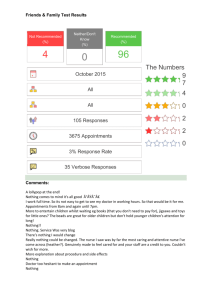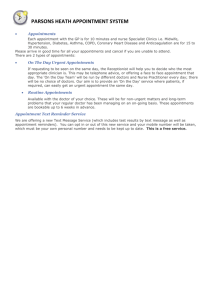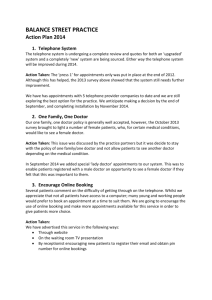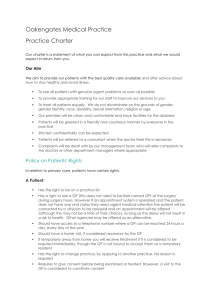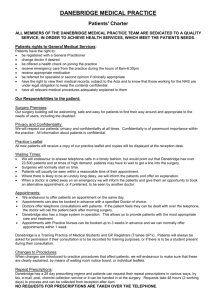Hurley Clinic Patients` Participation Group
advertisement
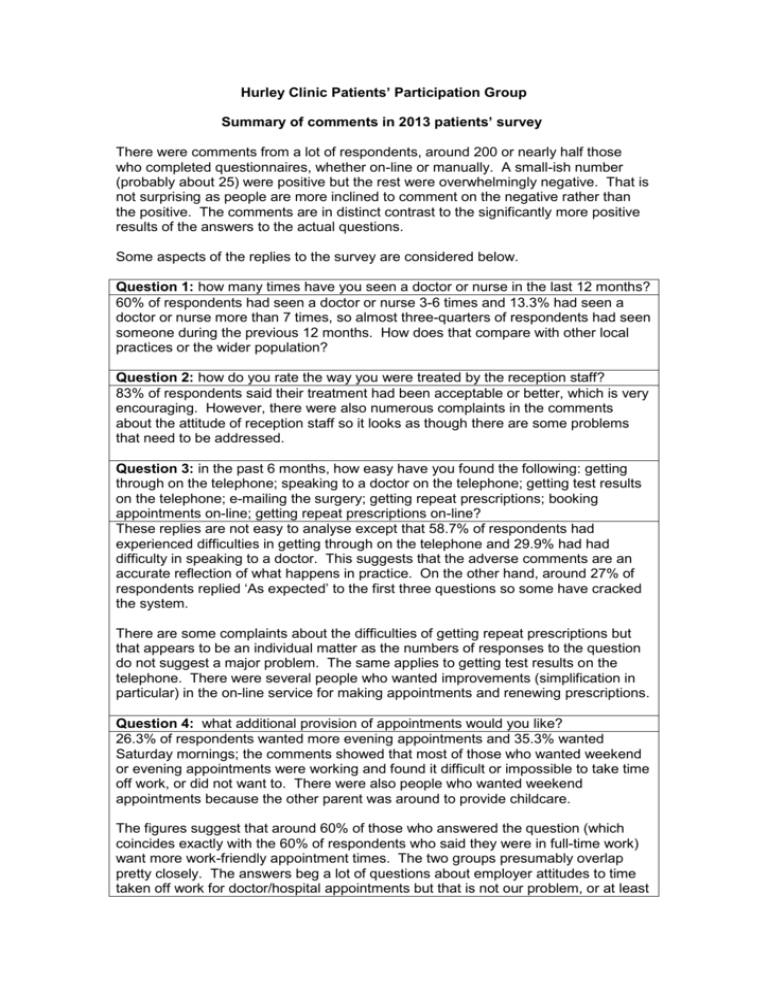
Hurley Clinic Patients’ Participation Group Summary of comments in 2013 patients’ survey There were comments from a lot of respondents, around 200 or nearly half those who completed questionnaires, whether on-line or manually. A small-ish number (probably about 25) were positive but the rest were overwhelmingly negative. That is not surprising as people are more inclined to comment on the negative rather than the positive. The comments are in distinct contrast to the significantly more positive results of the answers to the actual questions. Some aspects of the replies to the survey are considered below. Question 1: how many times have you seen a doctor or nurse in the last 12 months? 60% of respondents had seen a doctor or nurse 3-6 times and 13.3% had seen a doctor or nurse more than 7 times, so almost three-quarters of respondents had seen someone during the previous 12 months. How does that compare with other local practices or the wider population? Question 2: how do you rate the way you were treated by the reception staff? 83% of respondents said their treatment had been acceptable or better, which is very encouraging. However, there were also numerous complaints in the comments about the attitude of reception staff so it looks as though there are some problems that need to be addressed. Question 3: in the past 6 months, how easy have you found the following: getting through on the telephone; speaking to a doctor on the telephone; getting test results on the telephone; e-mailing the surgery; getting repeat prescriptions; booking appointments on-line; getting repeat prescriptions on-line? These replies are not easy to analyse except that 58.7% of respondents had experienced difficulties in getting through on the telephone and 29.9% had had difficulty in speaking to a doctor. This suggests that the adverse comments are an accurate reflection of what happens in practice. On the other hand, around 27% of respondents replied ‘As expected’ to the first three questions so some have cracked the system. There are some complaints about the difficulties of getting repeat prescriptions but that appears to be an individual matter as the numbers of responses to the question do not suggest a major problem. The same applies to getting test results on the telephone. There were several people who wanted improvements (simplification in particular) in the on-line service for making appointments and renewing prescriptions. Question 4: what additional provision of appointments would you like? 26.3% of respondents wanted more evening appointments and 35.3% wanted Saturday mornings; the comments showed that most of those who wanted weekend or evening appointments were working and found it difficult or impossible to take time off work, or did not want to. There were also people who wanted weekend appointments because the other parent was around to provide childcare. The figures suggest that around 60% of those who answered the question (which coincides exactly with the 60% of respondents who said they were in full-time work) want more work-friendly appointment times. The two groups presumably overlap pretty closely. The answers beg a lot of questions about employer attitudes to time taken off work for doctor/hospital appointments but that is not our problem, or at least not directly. There were similar answers to this question a couple of years ago when Rafik did the survey. The PPG then suggested that the practice should consider reverting to providing Saturday morning appointments. We were told pretty firmly that to do that would be extremely expensive for the practice and experience elsewhere showed that there was often a high proportion of no-shows for weekend appointments. Is there any other information about this? Is there real evidence of need? Are the early morning appointments (for which there is no significant demand in the survey but which are supposed to help those in work) always taken? Question 5: how quickly do you get to see a particular doctor? Only just over 5% of respondents saw a particular doctor on the same day or the next working day; 9.5% saw one within a week, 25.9% within two weeks and 12.6% in over two weeks. In other words, just over 80% of respondents see the doctor of their choice within two weeks but only 5% within anything like the 2-3 days that several of the comments suggested was desirable (ideal?). How does this compare with earlier years? And with other practices? And how can this be reconciled with the desire of many patients to have more continuity of clinical care and see the same doctor all the time, if possible? Question 6: how quickly do you get to see any doctor? 30% of respondents did not know the answer but 30% said they saw a doctor the same day or on the next working day and 25% within one week. In other words, 55% saw a doctor within a week. 12.6% said they had to wait over two weeks. This is not entirely consistent with the numerous complaints about very long waits to see a doctor but that may be partly the nature of the complainers. We also know that there have been times in the past year or so when there have been delays of a month or more for pre-booked appointments with named doctors. The complaints paint a very different picture from the answers to this question. This cannot all be attributed to strong feelings about the difficulty of getting an appointment, so what is the real picture? Question 7: how quickly do you get to see a nurse? Again, at least 30% did not know but nearly 25% saw a nurse within a week and nearly 25% on the same day or next working day. This looks fairly good but the comments imply that nurses are second best and people do not have proper confidence in them. The total responses are quite high. Question 8: if the need is urgent, have you see a member of the clinical team within a day, or on the next working day? For 37.5% of respondents, this need had not arisen but for 36.8% for whom it had, the answer was no. Only 25% had seen someone on the same day or next working day. The comments suggest that the inability to see a doctor soon because of what the patient deemed an urgent need is one of the principal complaints, even though for over a third of respondents the need had not arisen. Again, it may be partly the nature of the complainers. Question 9: how late is the doctor or nurse usually when you attend the surgery? Over 50% of respondents claimed to have waited less than 15 minutes, which seems a reasonably satisfactory performance and there are not all that many comments about unpunctuality. On the other hand, there is anecdotal evidence that on occasions things go very wrong and there are complaints about not being told about delayed appointments and the reasons for them. Question 10: do you have a regular doctor? If not, would you like one? 50.8% of respondents said that they did not have a regular doctor and would like one. Lack of continuity of care is also one of the main complaints listed in the comments. Question 11: if yes, how often do you see him/her? 13.6% said ‘almost always’ but 40.8% said ‘almost never’ which tends to confirm the complaints about lack of continuity of care. Is there anything more that can be done to encourage people to have more than one ‘preferred’ GP? And can the practice do anything to alter its recruitment and employment practices so that more continuity is easier to achieve? Question 12: are you happy with the range of services offered? A total of 63% of respondents were satisfied or more than satisfied which is encouraging although 11% did not know and 25% were dissatisfied. This needs to be looked at in the light of the withdrawal of the diabetic nurse service. Question 14: is access to the surgery difficult, acceptable or easy? Only 2% found it difficult although there were a couple of complaints about doors that were difficult to manage. Not clear which door(s) that meant. Question 15: is the surgery dirty, as clean as expected or cleaner than expected? 77% found it as expected and 17% cleaner. There were 5.5% who found it dirty and there were quite a few complaints about the condition of the waiting area (lack of magazines, disappearance of the fish tank etc). Question 17: what is your age group? Over 50% of respondents were aged between 25 and 44, which may be a fair reflection of the age distribution of the Hurley’s patients but certainly does not reflect the much higher usage by the young and the old. It does, however, explain the relatively large number of respondents who are in full-time work. It may also explain some of the complaints such as those about repeat prescriptions and test results. Question 18: what is your employment status? 60.6% of respondents said that they were in full-time employment and this needs to be checked against other sources as it is almost certainly not fully representative of the total among all patients. It explains the high level of demand among the complainants for more evening and weekend appointments. 10% said they were unemployed which is probably lower than the area average. Question 19: ethnic origins. 53.5% said they were white British and 16% black African or black British. How do these figures compare with the practice’s own records? Lack of time prevented a proper analysis of the comments but some points stand out: Lack of availability of urgent/emergency appointments coupled with dislike of August 2013 changes. Despite the queue, the old system seems to have been surprisingly popular with some, probably because it was seen as an effective way of getting short-notice/emergency/walk-in appointments. There appears to be some resistance to the need to go through a nurse with the new system and a lack of trust in the judgment of nurses, especially when young children are involved. Some complaints about not being rung back within the time specified. Difficulty of getting through on the telephone in the mornings. Long waits (often 2-3 weeks or more) for any normal pre-booked appointment, particularly with named doctors. Similar complaints about general lack of appointments and consequent difficulty of getting an appointment at short notice Lack of continuity of care because of high doctor turnover and many part-time doctors Lot of requests for more appointments outside normal working hours (evenings and weekends in particular) for those in work Relatively few complaints about being kept waiting for On-line appointments and access need improving Some general complaints about negative staff attitudes – doctors and other clinical staff appearing dismissive etc. Also about racism, particularly among nursing staff. Lot of complaints about attitudes of reception staff Quite a few problems with repeat prescriptions Complaints about loos – lack of paper and soap as well as general cleanliness Several complaints about waiting area and how grubby/gloomy it is Lots of complaints about the Tannoy, particularly for those with hearing problems, and suggestions that patients would prefer to be fetched by the doctor A few complaints about the lack of the diabetic nurse and poor phlebotomy service Some grumbles about the difficulty of getting test results Some suggestions for more services – portable x-ray, etc Some respondents clearly have particular issues which cause them problems and which could probably be resolved if they were able to discuss those problems with the right person. The difficulty of getting an appointment at short notice when required, long waits for any pre-booked appointment and never seeing the same doctor twice were the three most frequent complaints. Several respondents thought it should always be possible to get an appointment within 2-3 days, claiming that that was what used to happen (did it?). There was also a worryingly large number of complaints about poor staff attitudes, particularly among the reception staff but also among some of the clinical staff. Of particular concern are the charges of racism although as the questionnaires are anonymous it is impossible to follow those up. For the fairly numerous patients who took the trouble to comment, there is clearly a gap between their expectations of the service the Hurley should provide and what they are actually getting. Some of the expectations are unrealistic and probably based on a system that did not exist in the past. What should the practice be doing now? There is a significant number of people who say they need appointments urgently, or think that they do, and who consequently ask for same-day or next-day appointments but mostly can’t get them so they go to A&E, with consequences we know. They also seem to think that under the previous appointments system (ie the infamous 8.00 am queue), they had what amounted to a walk-in or drop-in system for emergencies. If they are right, should the practice be thinking of having proper drop-in appointments on a first-come, first served basis? Everyone involved agrees that the present delays for non-urgent appointments are far too long. The responses to the survey (as opposed to the comments) do not entirely support that view, but what level of provision would reduce the delays to a reasonable level? There is a widespread perception that more appointments (ie more doctors and other clinical staff) ought to solve the problem of excessively long waits for an appointment but is that the whole story? Is everyone (the practice, the PPG and others) doing enough to try to manage the demand? PJB 3 November 2013
